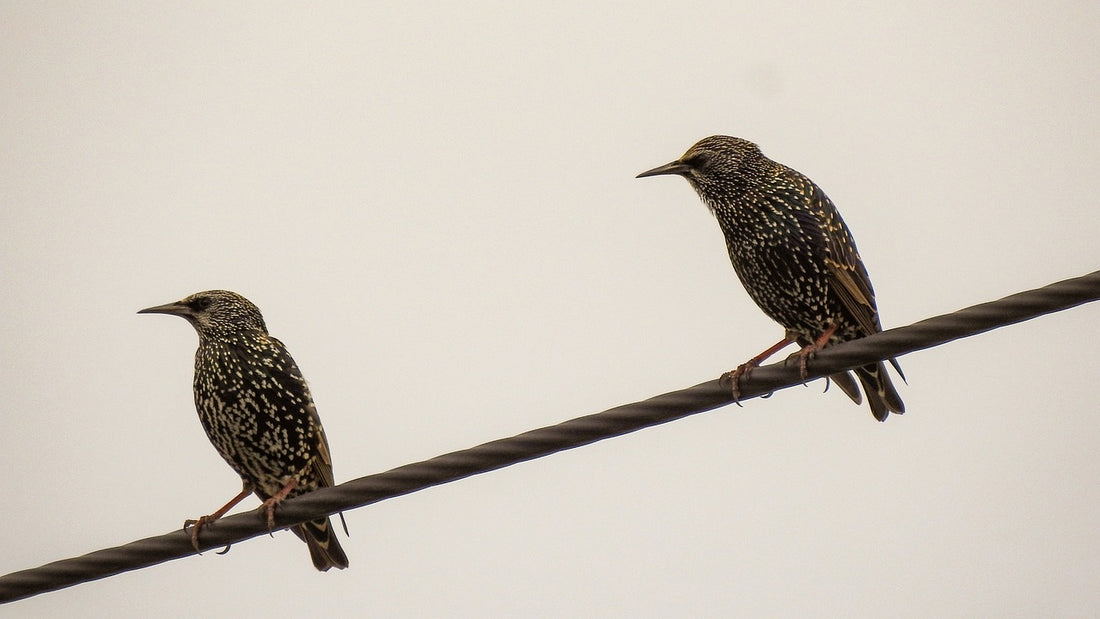From a distance, starlings appear to be black, but on closer inspection, they are beautifully glossy birds with a wonderful sheen of purples and greens. They are smaller than blackbirds at roughly 21cm in length and can be noisy. The starling (Sturnus vulgaris) has a reputation for being feisty and greedy, but this is somewhat undeserved. Starlings are interesting birds that can be seen in farmland, parkland, gardens, and towns.
Once abundant, the Starling has experienced significant decline and is now a red-listed bird of conservation concern. Undervalued as a garden visitor, perhaps because it lacks the colourful plumage of tits and finches and tends to display greed, the starling is nonetheless a fascinating bird which we should treasure. Thankfully, the UK remains home to some 1. 8 million starlings and also welcomes migrating birds in the winter months.
What is the starling’s distribution and population?
Starlings are widespread in the UK, occurring everywhere except for the highest regions of the Scottish Highlands. They are most common in southern England. During the winter months, the native population is swelled considerably by the arrival of birds from European breeding populations. Wintering Starlings roost communally, and enormous flocks can congregate at favoured sites. These perform amazing aerobatic displays. With so many birds using a roost, they can become a nuisance.
The number of starlings in the UK has declined significantly since the 1970s. The causes of this decline are not yet known. It is possible that the food supply has been the principal issue. Modern agricultural practices damage soils and biodiversity, reducing the number of invertebrates. There are currently 1, 800, 000 breeding pairs of starlings in the UK. The starling is red-listed as a species of conservation concern.
What do starlings eat?
Starlings feed mostly on soil-dwelling invertebrates including leatherjackets (the larvae of craneflies). From late summer, their diet starts to change and the birds take an increasing amount of plant material. They will also visit bird tables and will arrive in large numbers to devour everything in sight. Mealworms and suet will attract starlings to your garden.
Nesting in spring
As the days start to lengthen in the spring, the UK's resident Starlings will begin prospecting for nesting sites. They nest in holes and will also settle in nesting boxes. It is common for Scandinavians to erect boxes for starlings where the return of migrant starlings signals the beginning of spring. However, few people bother to provide boxes for starlings in the UK.
Female birds from the same colony lay their first clutches at the same time in late March or April. A clutch will consist of four or five pale blue eggs which take 12 days to incubate. The chicks fledge after 21 days. As egg laying is synchronised, all of the young starlings in any given area will emerge at the same time and will then hunt food with their parents. Juvenile starlings boast pale brown plumage but after the autumn moult, they sport the familiar white spots of their winter plumage. The spots are lost in spring.
Where do starlings nest?
Starlings like to nest in holes and cavities, especially in trees. They will also use holes in buildings, including occupied houses. These birds nest in loose colonies that feed communally. The male builds the base of the nest by creating a cup. The female completes it by lining it with grass, moss, and feathers. She lays 4-6 eggs and does most of the incubating. Chicks hatch after 12 days and fledge after 21-23 days.
Did you know?
The dazzling aerobatic displays of starlings are called murmurations. This is because the birds murmur in unison after they land.
Winter roosts
Highly social birds, starlings feed in flocks and roost communally during the winter months. Winter roosts can host several thousand birds and attract starlings from more than 15 miles away. In the late afternoon as the light begins to fail, the flocks can be seen heading for their roosts, picking up more birds along the way. The flocks exhibit amazing coordinated manoeuvres which create stunning aerial displays.
The most spectacular roosts in the UK now attract crowds of spectators! The country's most notable roosts include Brighton Pier, Sussex; Ham Wall in Somerset, Aberystwyth Pier; Leighton Moss, Lancashire; Fen Drayton, Cambridgeshire. When starlings leave the roosts at dawn, there is no repeat of the evening displays as they tend to stagger their departures. Birds leave the flocks at three-minute intervals and disperse across the countryside. So many birds can gather in one spot that roosts become excessively fouled with droppings and this can lead to the birds eventually moving elsewhere.
Adaptable birds
Hugely adaptable, starlings will forage anywhere for a meal including suburban lawns and open fields. They feed on Invertebrates and fruit but will also raid garden feeders.
Male starlings will sing for most of the year but cease for a few weeks during the post breeding-season moult. They create a chorus at winter roosts both when they arrive and before departing. Starlings are amazing mimics and will imitate the calls of other species and even mechanical sounds.
Treasure our starlings
Starlings are entertaining and gregarious birds which should be welcome visitors to our gardens. If you get the chance, it is worth visiting a roosting site to witness those incredible aerial displays which will certainly endear you to these amazing birds.

